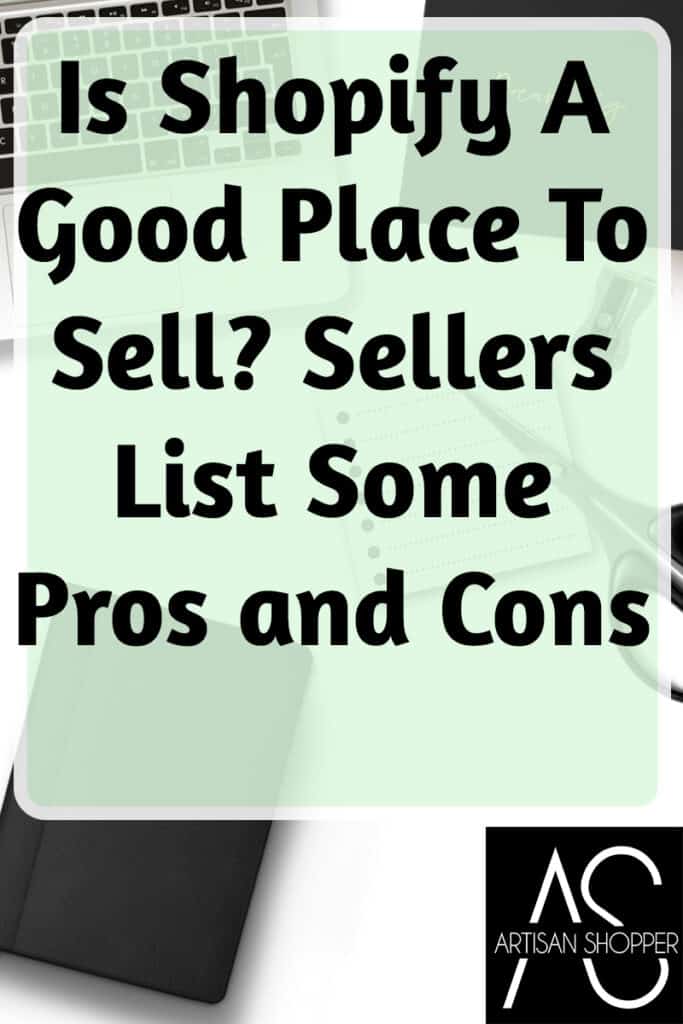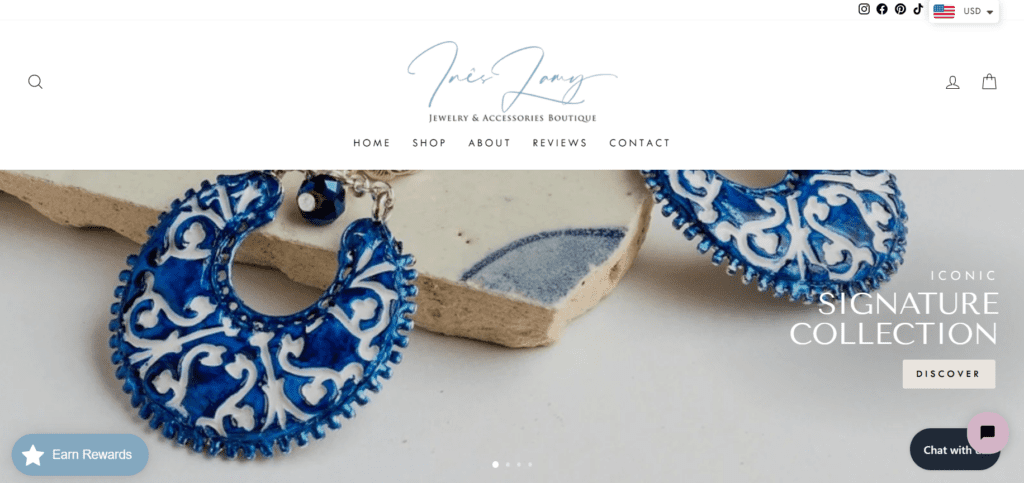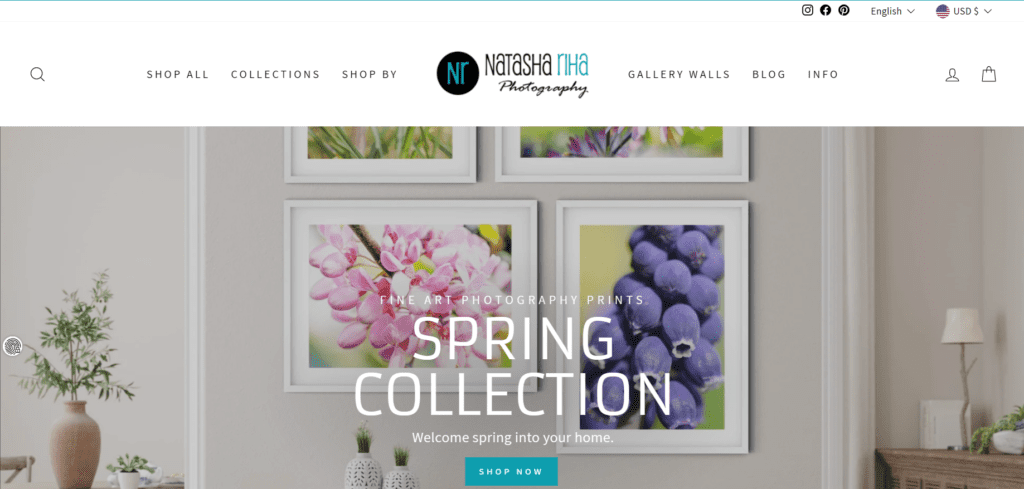When I asked the members of my EShop Success program what platforms they used for their websites other than Etsy, the vast majority said that they were on Shopify.
Shopify is one of the largest website-building platforms for e-commerce websites, and because of that, it’s also one of the ones that gets recommended a lot.
It’s not perfect, though, so read on to see what different members think about the pros and cons of whether Shopify is a good place to sell.

Table of Contents
Some of the links in this article are affiliate links that will pay a small commission if they’re used to purchase something. To see the entire affiliate policy click here.

The Pros of selling on Shopify.
The benefits of selling on Shopify include the ease of getting a website set up, and the support that Shopify offers.
Shopify is relatively easy to use and figure out.

Helen, the owner of Helen Makadia Fine Art , has a Shopify website to sell her photography. She says “I would say Shopify is simple to set up with their templates. Always explore the free templates before buying one. Shopify has a lot of information to help set it up, and they have a YouTube channel with all their videos.”
, has a Shopify website to sell her photography. She says “I would say Shopify is simple to set up with their templates. Always explore the free templates before buying one. Shopify has a lot of information to help set it up, and they have a YouTube channel with all their videos.”
Lisa, who owns Fuse Muse Fused Glass, uses Shopify, too. She says “At first I had trouble getting views, but as I am learning the true power of SEO, I have seen my impressions and views rise. It takes a long time, but I am creeping up a little every week. Pros of Shopify are that it is really easy to set up and get going. I am not a computer/technology person at all. It doesn’t get easier than buying your domain, choosing your theme, and then adding in all your stuff. Shopify has pretty good customer service as well. I usually chat online with someone and it is very rare to have a problem getting your issue fixed. (my issues anyway).
uses Shopify, too. She says “At first I had trouble getting views, but as I am learning the true power of SEO, I have seen my impressions and views rise. It takes a long time, but I am creeping up a little every week. Pros of Shopify are that it is really easy to set up and get going. I am not a computer/technology person at all. It doesn’t get easier than buying your domain, choosing your theme, and then adding in all your stuff. Shopify has pretty good customer service as well. I usually chat online with someone and it is very rare to have a problem getting your issue fixed. (my issues anyway).
Tracey Lipman, the owner of Traceylipman.com , says “I like Shopify but honestly had to get help to set up my shop as I could not get it to look as professional as I wanted it to. Now that it is set up, I can (mostly) run the backend myself. Help is available for the things I get stuck on, as it is such a well-known platform, and someone knows the answers.”
, says “I like Shopify but honestly had to get help to set up my shop as I could not get it to look as professional as I wanted it to. Now that it is set up, I can (mostly) run the backend myself. Help is available for the things I get stuck on, as it is such a well-known platform, and someone knows the answers.”
Anne, who owns a couple of businesses including French Vintage Prints , says that she uses Shopify and that “I started on WordPress but it was too much maintenance.”
, says that she uses Shopify and that “I started on WordPress but it was too much maintenance.”

Ines, owner of Ines Lamy agrees, adding that “I used to have WooCommerce but gave up. Too much trouble to update constantly and the site didn’t look pro enough. So it took a while and finally decided to go to Shopify. No more hassle on the basics.”
agrees, adding that “I used to have WooCommerce but gave up. Too much trouble to update constantly and the site didn’t look pro enough. So it took a while and finally decided to go to Shopify. No more hassle on the basics.”
Cindy, who owns The Scrapologist , says “I chose Shopify because I am slowly moving from Etsy to my own site and just wanted to get something up and running quickly. When time permits, I am gradually going in and tweaking things; it still doesn’t look anything like what I envision as the end result, but at least my shop name and listings are there for Google to find. And it was relatively simple to automate between Etsy and Shopify so, for now, I only have to handle one online shop.
, says “I chose Shopify because I am slowly moving from Etsy to my own site and just wanted to get something up and running quickly. When time permits, I am gradually going in and tweaking things; it still doesn’t look anything like what I envision as the end result, but at least my shop name and listings are there for Google to find. And it was relatively simple to automate between Etsy and Shopify so, for now, I only have to handle one online shop.
“Shopify has apps that will add new listings and import reviews from Etsy; there is also an app that will take down listings from Shopify that I have sold out or de-activated from my Etsy shop. Shopify can also host my future blog, and they recently added an email list function so I was able to stop paying extra for an email service! The customer service has been outstanding so far, and they even did some free work for me, adding an installment payment option to my shopping cart.”
Shopify offers apps for added functionality.
Lisa, the owner of Lucy’s Vintage Gifts, says “I use Shopify and like it because I can use the shuttle app to easily update my Etsy items. Since I sell vintage And one-of-a-kind, the shuttle app syncs things for my Shopify site without me having to stress.”

Natasha, the owner of Natasha Riha Photography , says “I use Shopify. I love how easy it is to set up their templates and their excellent customer service. Another big plus for me is that they also have their own (free) app now that lets you translate your shop to other languages quite easily.”
, says “I use Shopify. I love how easy it is to set up their templates and their excellent customer service. Another big plus for me is that they also have their own (free) app now that lets you translate your shop to other languages quite easily.”
Shopify support and tech make it worth the price.
Tina, who owns Bello Glass By Tina , says “Shopify, free template. Easy to import Etsy listings. Sets up quickly for the most part if you’re not fussy. Price-wise, I consider Shopify a deal.”
, says “Shopify, free template. Easy to import Etsy listings. Sets up quickly for the most part if you’re not fussy. Price-wise, I consider Shopify a deal.”
Lisa, the owner of Spangler Stitchin’ Station, says “Shopify is professional, fairly easy to set up, you don’t have to constantly do updates like you do if you have WooCommerce.”

Jes, who owns Sixth Spice , uses Shopify and says “I love how easy it is! I just used a free template and there are more than enough options on it to achieve a good-looking, functional website. I can change things around, make new sections for my shop and integrate everything with social media seamlessly. I love Shopify and really recommend it for its ease of use and how simply it integrates with everything. If you buy the yearly plan you save $$$ as well.”
, uses Shopify and says “I love how easy it is! I just used a free template and there are more than enough options on it to achieve a good-looking, functional website. I can change things around, make new sections for my shop and integrate everything with social media seamlessly. I love Shopify and really recommend it for its ease of use and how simply it integrates with everything. If you buy the yearly plan you save $$$ as well.”
Destiny, who owns Home Branded , says “I’ve had Shopify for about a year now and I like how I can get a nice site with little expense. I use a free template and just a few add-ons that are free as well. I do like how it integrates with Pinterest and other apps. Since I want to be found on Google and other search engines, such as Pinterest, as easily as possible, Shopify was a good choice for me.”
, says “I’ve had Shopify for about a year now and I like how I can get a nice site with little expense. I use a free template and just a few add-ons that are free as well. I do like how it integrates with Pinterest and other apps. Since I want to be found on Google and other search engines, such as Pinterest, as easily as possible, Shopify was a good choice for me.”
Paula, the owner of Paula McNulty Designs , says “I switched last year from using a WordPress/WooCommerce website to Shopify. I couldn’t keep up with the plug-in updates, back-ups, and glitches with the WooCommerce site. With Shopify, I don’t have to worry about that at all which is very nice. I love the ease of the new 2.0 templates that are free to use and I’m able to keep the cost down by subscribing with an annual membership and using free apps.”
, says “I switched last year from using a WordPress/WooCommerce website to Shopify. I couldn’t keep up with the plug-in updates, back-ups, and glitches with the WooCommerce site. With Shopify, I don’t have to worry about that at all which is very nice. I love the ease of the new 2.0 templates that are free to use and I’m able to keep the cost down by subscribing with an annual membership and using free apps.”
The Cons of selling on Shopify.
The downside of using Shopify came down to technical issues, for the most part.
Added costs and problems with extra apps.
Karen, who owns KalxDesigns , says that she uses Shopify, and that “I like the platform very much. My main comment/advice regarding this platform is to carefully do your research before selecting a theme for your site. There are free ones and paid ones, but they offer different functionality.
, says that she uses Shopify, and that “I like the platform very much. My main comment/advice regarding this platform is to carefully do your research before selecting a theme for your site. There are free ones and paid ones, but they offer different functionality.
“For example, the theme I selected did not offer customers the ability to choose between US and Canadian currency, so I had to pay a third party to add it for me by amending the code. Nor does it offer the ability to turn off the check out while leaving the shop open, e.g., for when on vacation. Many people just go for the ‘look’ they want for their site, but do not examine what they are really getting. It may cost extra to get a more functional site, but you will end up saving in the long run because amending a theme can be quite expensive. I am speaking from experience, unfortunately.”
Lisa adds “Negatives, you have to pay extra for apps such as wish list, reviews, etc.””
Tina says that in general, she likes selling on Shopify, but that “Changing some features requires editing code, and that seems daunting for non-code writers like me. However, there is plenty of help out there for any issue when it comes to Shopify.”
Lisa adds “Cons of Shopify are there are many add-ons that can help you shop – or hurt it. The more you choose, the slower your site gets, and you get downgraded for speed issues with Google. Another issue is some of the help topics are written in a foreign language – namely computer speak (ie. stuff that makes sense to people who write code or do such things for a living, just not to me). Sometimes the language barrier is too much.
“One last con that makes me wish it was more like Etsy is I really wish that on the orders page, it listed what each individual ordered. Instead, it only has the order number and you have to open or print them out to see what you need to work on. This for me is a big thing, although it may not be for everyone.”
Jennifer, who has shifted from e-commerce to focus more on blogging, says that she used to use Shopify but that since she needs a more blog-focused platform, so she’s using WordPress now.
Her impressions about Shopify were that “If you want to have blog categories on Shopify, you have to know those categories before you start. You basically have to do a separate blog for each category and you can’t change the category later like you can on WordPress. Also, if you want to monetize your blog with ads on Shopify it is basically impossible unless you know coding.”
(This isn’t something that you might be concerned about if your focus is on having an e-commerce site and selling products, but it’s definitely something to keep in mind if you do want a more complex blog.)
Sherri, who owns Sherri O Designs, switched to Shopify from another platform, and she likes the look and flexibility of her site, but adds that “Shopify is a lot more complicated with all of its apps. I’ve had to navigate the coding to get some things the way I want, and most of the help articles end with ‘Hire a Shopify expert,’ which is frustrating.”
switched to Shopify from another platform, and she likes the look and flexibility of her site, but adds that “Shopify is a lot more complicated with all of its apps. I’ve had to navigate the coding to get some things the way I want, and most of the help articles end with ‘Hire a Shopify expert,’ which is frustrating.”
Problems that non-US sellers face with Shopify.
Natasha adds “One thing I don’t like is that they are not 100% GDPR compliant (e.g. you need an app for a GDPR compliant cookie banner, you can’t do a newsletter sign-up form that is fully GDPR compliant). This might not be that big of an issue for US-based shops, but it is problematic for shops in the EU.”
Tracey, who’s also not US-based, says “I love the apps that make using Shopify and Etsy easier BUT I think Shopify is best for US sellers. I am in Israel and the cost of adding an Israeli payment processor for credit cards is really high. This means I am using Paypal (which not everybody likes and has high fees) and I also need to pay Shopify for each sale, as my payments need to go through them (which I don’t think you need to do if you live in the US.)”
Shopify is a solid choice when it comes to selling online, and it makes it easy to set up a website for people who aren’t super-familiar with coding.
If you’re familiar with the possible pros and cons of the platform, Shopify is a good option to investigate.

